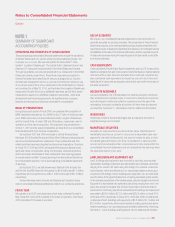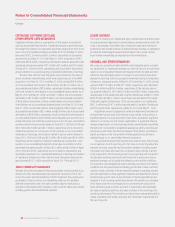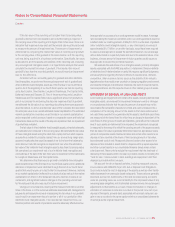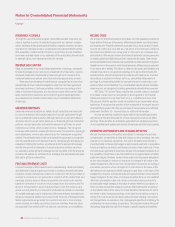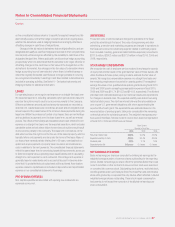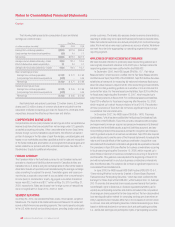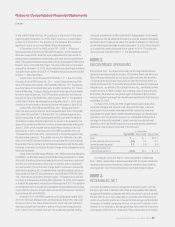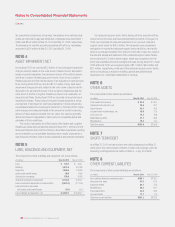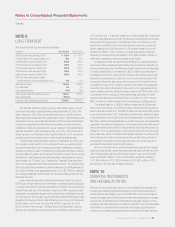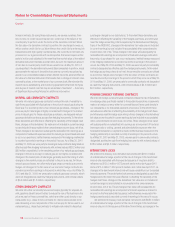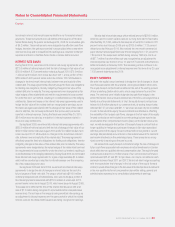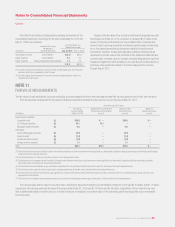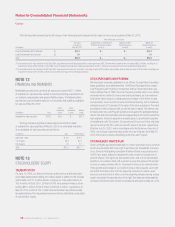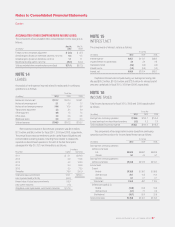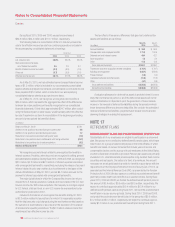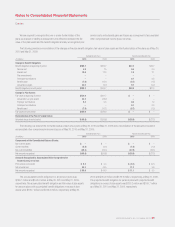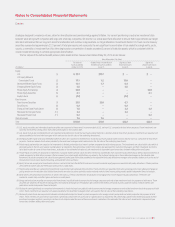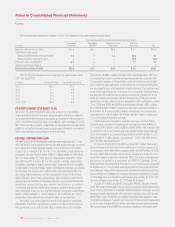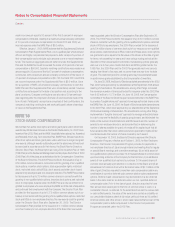Red Lobster 2010 Annual Report Download - page 55
Download and view the complete annual report
Please find page 55 of the 2010 Red Lobster annual report below. You can navigate through the pages in the report by either clicking on the pages listed below, or by using the keyword search tool below to find specific information within the annual report.
benchmark interest rate would cause variability in our forecasted interest
payments. These instruments were all settled at the issuance of the New
Senior Notes during the quarter ended August 24, 2008 for a cumulative gain
of $6.2 million. These instruments were designated as effective cash flow
hedges, therefore, the gain was recorded in accumulated other comprehen-
sive income (loss) and is reclassified into earnings as a reduction to interest
expense as interest on the New Senior Notes or similar debt is incurred.
INTEREST RATE SWAPS
During fiscal 2010, we entered into interest rate swap agreements with
$375.0 million of notional value to limit the risk of changes in fair value of our
$150.0 million 4.875 percent senior notes due August 2010, $75.0 million
7.450 percent medium-term notes due April 2011, and a portion of the
$350 million 5.625 percent senior notes due October 2012 attributable to
changes in the benchmark interest rate, between now and maturity of the
related debt. The swap agreements effectively swap the fixed rate obligations
for floating rate obligations, thereby mitigating changes in fair value of the
related debt prior to maturity. The swap agreements were designated as fair
value hedges of the related debt and met the requirements to be accounted
for under the short-cut method, resulting in no ineffectiveness in the hedging
relationship. Gains and losses on the interest rate swap agreements used to
hedge the fair value of the related debt are recognized in earnings, as are
the losses and gains associated with the changes in fair value of the related
debt. In addition, the net swap settlements that accrue each period are
reported in interest expense. During the fiscal year ended May 30, 2010,
$3.4 million was recorded as a reduction to interest expense related to
these net swap settlements.
During fiscal 2009, we entered into interest rate swap agreements with
$225.0 million of notional value to limit the risk of changes in fair value of our
$150.0 million senior notes due August 2010 and $75.0 million medium-term
notes due April 2011 attributable to changes in the benchmark interest
rate, between now and maturity of the related debt. The swap agreements
effectively swap the fixed rate obligations for floating rate obligations, thereby
mitigating changes in fair value of the related debt prior to maturity. The swap
agreements were designated as fair value hedges of the related debt and met
the requirements to be accounted for under the short-cut method, resulting in
no ineffectiveness in the hedging relationship. During fiscal 2009, we ter minated
these interest rate swap agreements for a gain of approximately $1.9 million,
which will be recorded as a reduction to interest expense over the remaining
life of the related long-term debt.
During fiscal 2005 and fiscal 2004, we entered into interest rate swap
agreements to hedge the risk of changes in interest rates on the cost of a
future issuance of fixed-rate debt. The swaps, which had a $100.0 million
notional principal amount of indebtedness, were used to hedge a portion of
the interest payments associated with $150.0 million of unsecured 4.875
percent senior notes due in August 2010, which were issued in August 2005.
The swaps were settled at the time of the related debt issuance with a net
loss of $1.2 million being recognized in accumulated other comprehensive
income (loss). The net loss on the swaps is being amortized into earnings as
an adjustment to interest expense over the same period in which the related
interest costs on the related debt issuance are being recognized in earnings.
We also had interest rate swaps with a notional amount of $200.0 million,
which we used to convert variable rates on our long-term debt to fixed rates
effective May 30, 1995, related to the issuance of our $150.0 million 6.375
percent notes due February 2006 and our $100.0 million 7.125 per cent
debentures due February 2016. We received the one-month commercial
paper interest rate and paid fixed-rate interest ranging from 7.51 percent to
7.89 percent. The swaps were settled during January 1996 at a cost to us
of $27.7 million. A portion of the cost was recognized as an adjustment to
interest expense over the term of our 10-year 6.375 percent notes that were
settled at maturity in February 2006. The remaining portion continues to be
recognized as an adjustment to interest expense over the term of our 20-year
7.125 percent debentures due 2016.
EQUITY FORWARDS
We enter into equity forward contracts to hedge the risk of changes in future
cash flows associated with the unvested, unrecognized Darden stock units.
The equity forward contracts will be settled at the end of the vesting periods
of their underlying Darden stock units, which range between four and five
years. The contracts were initially designated as cash flow hedges to the
extent the Darden stock units are unvested and, therefore, unrecognized as a
liability in our financial statements. In total, the equity forward contracts are
indexed to 0.8 million shares of our common stock, at varying forward rates
between $27.57 per share and $41.17 per share and can only be net settled
in cash. To the extent the equity forward contracts are effective in offsetting
the variability of the hedged cash flows, changes in the fair value of the equity
forward contracts are not included in current earnings but are reported as
accumulated other comprehensive income (loss). As the Darden stock units
vest, we will de-designate that portion of the equity forward contract that no
longer qualifies for hedge accounting and changes in fair value associated
with that portion of the equity forward contract will be recognized in current
earnings. We periodically incur interest on the notional value of the contracts
and receive dividends on the underlying shares. These amounts are recog-
nized currently in earnings as they are incurred.
We entered into equity forward contracts to hedge the risk of changes in
future cash flows associated with employee-directed investments in Darden
stock within the non-qualified deferred compensation plan. The equity forward
contracts are indexed to 0.2 million shares of our common stock at forward
rates between $23.41 and $37.44 per share, can only be net settled in cash
and expire between fiscal 2011 and 2013. We did not elect hedge accounting
with the expectation that changes in the fair value of the equity forward
contracts would offset changes in the fair value of the Darden stock investments
in the non-qualified deferred compensation plan within selling, general and
administrative expenses in our consolidated statements of earnings.
DARDEN RESTAURANTS, INC. | 2010 ANNUAL REPORT 53
Notes to Consolidated Financial Statements
Darden


